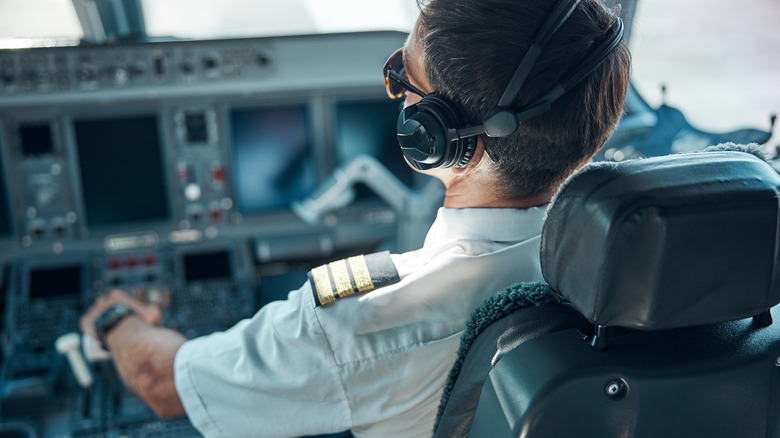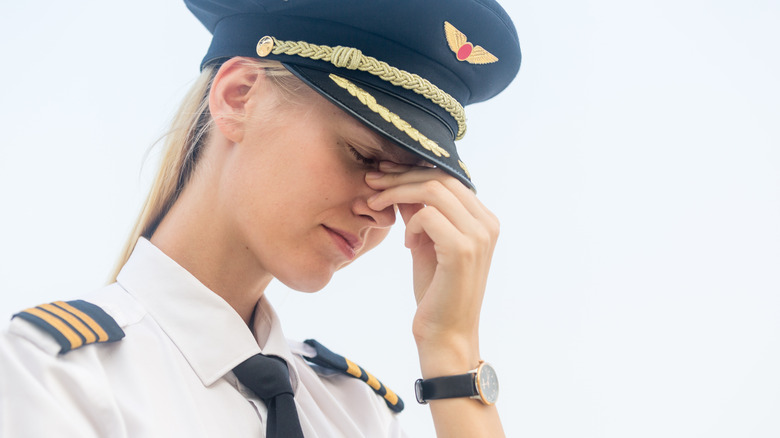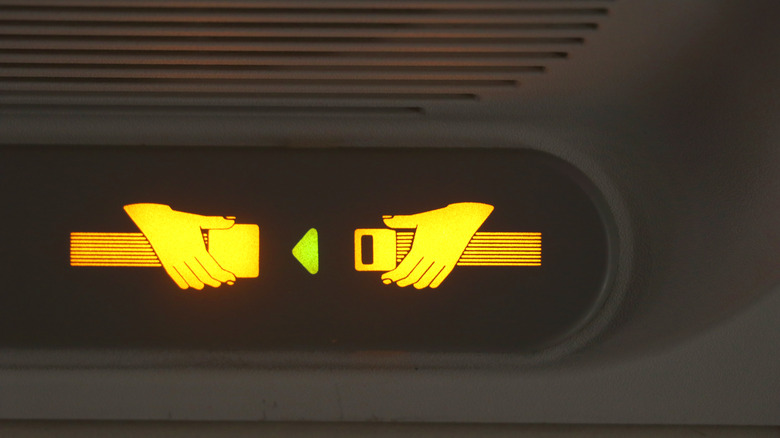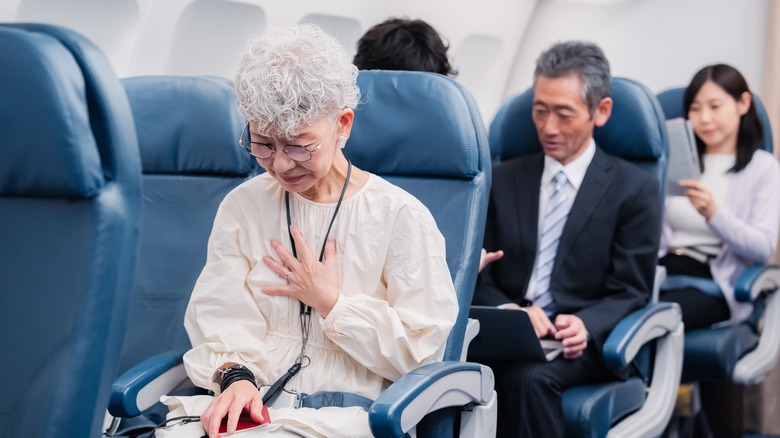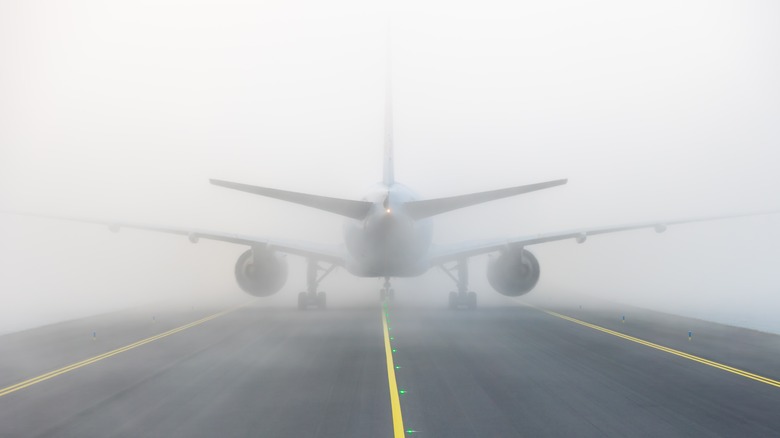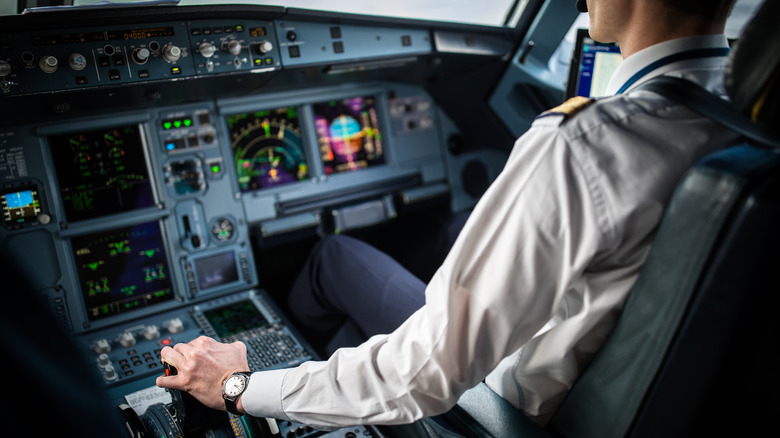How Much Do Pilots Really Rely On Autopilot? Here's What A Captain Told Us
During every flight that you've ever been on, there's probably been a period of time when the autopilot system has been engaged to help fly the plane. It's impossible for passengers to recognize when this transition takes place, however, because the system has become so advanced and reliable in its capabilities. It's been designed to monitor the plane's speed, direction, pitch, and altitude. As a result, it's able to maintain a flight plan in conjunction with the pilot who determines when this system is activated. Many people may wonder if autopilot is used very often, and in what ways is it helpful? In an exclusive interview with Explore, Captain Richard Levy explains that there are many reasons why autopilot is regularly integrated with a pilot's flight plan. It's beneficial during emergencies, and it also provides assistance during the more routine parts of a flight. Overall, it can make you feel safer on your trip by knowing it's in use.
Captain Levy served as a professional pilot for a major U.S. international airline for over 40 years. Upon reaching his mandatory retirement age of 65, he transitioned to another major airline, where he now serves as a flight simulator instructor. In addition to this role, Levy provides consultation as an aviation expert for media outlets as well as in cases of litigation. Here are his insights about the benefits of the autopilot system.
Autopilot can prevent pilot fatigue
Captain Levy begins by explaining that the autopilot system is valuable to a pilot, either as a way to survive a long-haul flight across the continent or even just a short trip. He describes the system as a pilot's "best friend," who is "helpful, needed, and dependable" on any flight. He explains how autopilot is useful during a flight: "Turn the autopilot on and the airplane flies in the desired direction, at the desired altitude, and can very possibly make one smooth landing in times of good visibility or even thick fog." For those who may wonder how often a pilot depends on this type of assistance, Levy answers that as a professional who flew around the world for almost 41 years: "There was not a single flight where the autopilot was not used."
The captain goes on to explain several reasons why using this system is a way to ensure the flight's safety. The first reason he mentions has to do with helping a pilot manage fatigue during a flight. "We all know that feeling tired or fatigued can affect tip-top decision making. If the autopilot is flying the airplane, the pilots are able to concentrate on good, safe, and effective decision making," he claims. Pilots are often required to make judgments that can affect their flight plans, and the use of autopilot allows them to remove distractions and have the clarity of mind to make these choices carefully.
Autopilot is helpful during turbulence
Levy provides several examples of challenging situations where the autopilot can provide valuable assistance during a flight, such as if the plane encounters turbulence. "Once again, the autopilot does not become tired like a human during flights, especially when turbulence can take its toll," he shares. Levy describes what happens when a flight starts to experience this disruption. "In turbulence, updrafts and downdrafts are prevalent, but the autopilot still flies the airplane in the assigned altitude and keeps the airplane on the programmed route of flight," he explains. This assistance can be a great help, as the constant effort to combat the effects of this motion can be taxing on a pilot's energy level and concentration.
That said, there are some occasions when the pilot may choose to deactivate the system and fly the plane by hand instead, such as if the turbulence becomes very heavy. Levy explains that in response to these conditions, the autopilot system may actually be making so many corrections that it can actually create discomfort for passengers, especially those who experience anxiety when flying through turbulence. At this point, the pilot may decide to turn off the system and fly the plane manually for a period of time. This is also the moment that Levy declares, "Of course, the captain will make an announcement to the passengers, which is backed up by ... the flight attendants: 'Please be sure you are seated with seat belts fastened!'"
Autopilot allows pilots to make critical decisions during an emergency
Another example of a situation where autopilot can be of great help is if a sudden medical emergency takes place on board the aircraft during a flight. Levy explains that in this scenario, it's often necessary to make urgent decisions quickly. He says, "Should a passenger or crew member become ill, and an intermediate landing must be made, there is an extensive list of mandatory communications required by [the] flight deck crew." He provides several examples of different questions that must be answered as the pilot determines the necessary course of action. "Is there a doctor on board? What do the flight attendants observe and recommend? Is there a company doctor to consult with? Which airport does the company flight dispatcher recommend for an intermediate landing? What about weather and airport facilities? And on and on." Levy also points out that if an intermediate landing is necessary, the pilot must also obtain clearance from the air traffic control officials at the new destination.
These determinations must be made quickly, and the pilot must be able to assess the situation as completely as possible. In this type of emergency, the autopilot system is particularly useful, because it allows the pilot to make these considerations safely. "Using the autopilot to fly the airplane naturally allows the pilots to communicate with everyone and comply with company policies and procedures, allowing an expeditious landing to be made," Levy explains.
Autopilot is useful in foggy conditions
The pilot would also need to consult emergency procedures if a mechanical issue occurred during the flight. "If a system on the aircraft creates a situation where a checklist must be consulted for guidance and a similar need for a landing at a nearby airport must be made, then the autopilot, once again, permits the pilots to communicate, assess the risks, make a good decision, and begin a diversion," says Levy. This type of scenario has the potential to be alarming to passengers. Levy points out that autopilot can help create a climate where the best solution is found. "We all make our best decisions when we reduce stress and focus on the paramount priority: safety."
In addition to these emergency situations, a pilot may also depend on autopilot to help navigate a more common challenge: flying through thick fog. Some popular U.S. airports can be total nightmares to fly in and out of, such as Los Angeles International Airport that constantly contends with dense ocean fog. Levy says, "There comes a time when landing in situations of reduced visibility can only be made with automation, otherwise known as the autopilot." He explains that "some autopilots are certified for fully automatic landings. Other autopilots are good only down to 50 feet above the runway." At that point, "the captain takes over and lands the aircraft," Levy states.
Autopilot is an essential tool
Levy points out that autopilot not only enhances the safety of air travel, but it also helps flights stay on schedule by maintaining a consistent flight plan. This means that passengers and crew don't have to manage as many long travel delays. Despite these benefits, Levy poses the question, "Is the autopilot on a commercial airliner the be-all and end-all? Not yet," he says. "The autopilot cannot conduct takeoffs or manually taxi the aircraft." He also points out that its purpose is not to take the place of training and experience. "Does that mean a pilot becomes less proficient in basic flying skills?" He emphasizes, "Absolutely not!" As a current flight simulator instructor for a major airline, Levy focuses on helping pilots build these essential skills. He also observes that pilots always have the opportunity to do what they love by stating, "That is where the fun is: Disconnect the autopilot and manually fly the aircraft to your heart's content!"
As Levy points out during the interview, a pilot will often depend on autopilot to help manage travel fatigue, address emergency situations, and maneuver through difficult flight conditions. Ultimately, this assistance will enable the pilot to create a safer and more comfortable experience for those on board the plane. Levy explains that whether it's a long or short flight, it's beneficial for a pilot to gain some assistance from "that little wonder on the flight deck called the autopilot." For more information on Captain Richard Levy, visit his website at aviationexpertconsulting.com.
